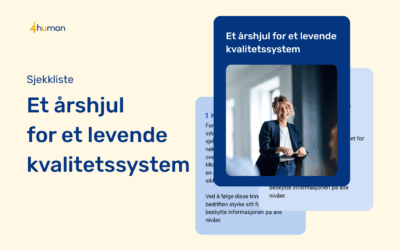Sustainability management

Customers are becoming increasingly aware of sustainability challenges. As a result, they are making more demands on their suppliers in this area - and more companies want to introduce a sustainability management system.
Pollution kills millions of people every year, plastic floods the oceans, animals become extinct at a rapid pace and the rainforest is cut down like never before. Consumers are exposed to horrific stories of workers working in appalling conditions. Consumers are becoming more and more aware of these challenges. In addition, a number of NGOs are working to put increasing pressure on companies to produce products and services in a sustainable way.
Benefits of a strong focus on sustainability
How to work with sustainability management?
But what exactly is a sustainability management system and how does it differ or overlap with the classic quality management system ISO 9001 or environmental management system ISO 14001?
Your company may already be certified to one of these standards, or in the process of becoming so. So, what needs to be in place next to ensure sustainability integration? How can your company become more sustainable through its management system? Is ISO 26000 (Guidance on Corporate Social Responsibility) enough for you to think holistically about sustainability?
A number of the standards in this area may also be relevant to consider:
There are several international standards and guidelines that provide good guidance to companies that want to act responsibly and sustainably, such as Global Compact, the ILO's core conventions, OECD Guidelines for Multinational Enterprises, the UN Guiding Principles on Business and Human Rights and not least UN Sustainable Development Goals.
A good start in ISO 9001
- It must be based on a policy that is anchored in management and provides guidelines for activities and measures that are integrated into the company's daily operations.
- You need to check that you are delivering on your promises and that you are complying with laws and requirements from authorities, customers and other stakeholders.
- Risks must be identified and measures to reduce risk must be in place.
- The company must set relevant and measurable goals and report on progress.
- Employees should have the relevant skills to do their job properly.
- Deviations must be registered and corrective measures initiated.
- Good dialog with stakeholders is important.
Common goals in quality and sustainability
In addition, quality management is about avoiding mistakes and waste, which is just as relevant if you look at it from a sustainability perspective - i.e. reducing the use of resources and reusing as many materials as possible. For example, SDG 12 "Responsible consumption and production" is about doing more with fewer resources. Safety in the workplace, a healthy and safe working environment with satisfied employees are just as natural elements in quality management as they are in the sustainability goals.
Many common denominators
What is sustainability for you?
In the same way that ISO 9001 certification requires you to think about "What is quality for us?", you need to think about "What is sustainability for us?". No one can work with everything and an important principle is to understand what is essential for your company. Is it the products we produce and/or the way we produce them that is at the heart of our impact on the world? Which of the UN Sustainable Development Goals are relevant to our company? Will your focus be on clean water, chemical hazards, waste management and the natural environment around production sites? Is your industry particularly prone to corruption or is there a risk of human rights violations in your supply chain?
Once you've identified relevant sustainability goals or focus areas, you can start using the principles in the ISO standards to build a structure and systemize your sustainability work. You know - policy, risk mapping, and so on. The wheel of continuous improvement can be spun further with new content.
It's not just about structure, it also needs to be filled with the right elements. Although many distinguish between the terms corporate social responsibility and sustainability, the guidelines in ISO 26000 will provide good guidance on a number of the core themes of the UN Sustainable Development Goals. The standard was developed in a working group with over 500 participants from 100 countries, and close to 42 different international organizations, including OECD, WHO, ILO, EU, UN Global Compact and GRI. ISO 2600 offers guidance on:
- Organizational management
- Human rights
- Working conditions
- Environment
- Honorable business
- Consumer issues
- Local community engagement
The key to answering the question of whether this "holds" is held by you and your company. You are the ones who know your market, stakeholders and production methods best. You're the one who needs to identify what's material to you when it comes to sustainability. But - you don't have to reinvent the wheel.
Use the standards for navigation assistance
Sustainability can appear both as a tired phrase and as something very complex. Use the international standards that are out there as a guide. Choose what you want to prioritize. And integrate it into a robust management system that promotes continuous learning and improvement.
Spin the wheel further with Plan - Do - Check - Act, and you'll see that ISO standards are a great support tool for integrating sustainability into your business.
Want to know more?
Related posts
A year wheel for a living quality system
This checklist is designed to help you make the quality system an integral part of your everyday life. By using a...
11 steps to help you choose the right quality system
Investing in a quality system can quickly become a comprehensive process. For example, imagine buying your dream home....
8 practical steps to maintain ISO 9001 certification
8 steps to maintain ISO 9001 certification Ensuring that your ISO 9001 certification remains valid may seem like a...


